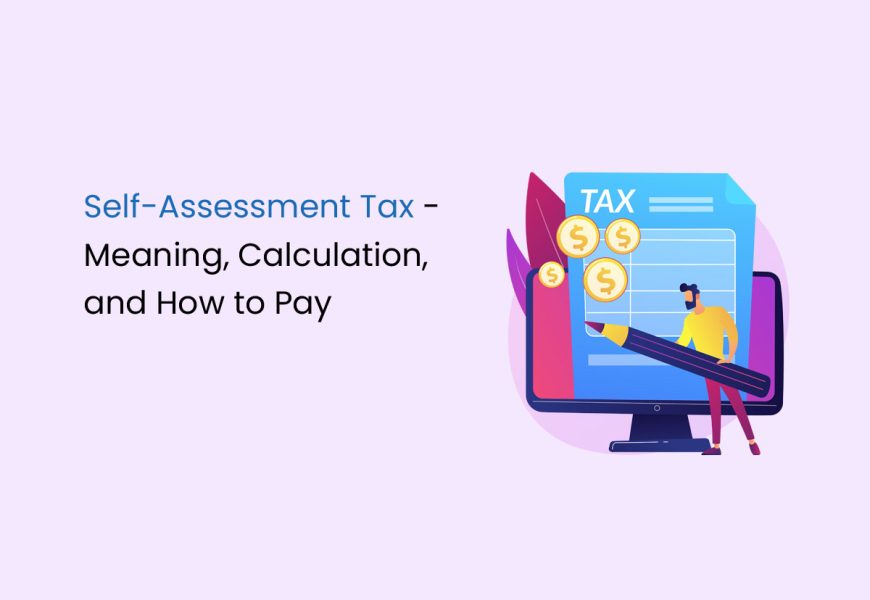Self-assessment tax refers to any pending tax liability left on an assessee’s evaluated income after reducing deductions, and the taxes paid have been considered before filing the income return. The income Tax Return (ITR) is not considered complete unless a taxpayer does not pay self-assessment tax.
Here’s an overview of self-assessment tax, its meaning, calculation, how to pay it, etc.
What is Self-Assessment Tax?
After an assessee Accounts for the deduction of TDS by the employer, collection of TCS by the recipient on behalf of the taxpayer, and Advance tax on their income, any balance tax left is Self-Assessment Tax (SAT). SAT arises when the tax paid on account of TDS, TCS, and advance tax is less than the actual tax liability.
Individuals are liable to pay SAT before filing their income tax returns. Taxpayers can pay it using Challan 280, a convenient form for payment of taxes to the government. This form can be used for physical and online payments.
This tax applies to all individuals and businesses, regardless of the type or size of their income.
It is important to note that taxpayers should pay the SAT as soon as possible during the close of the financial year to avoid interest on the outstanding tax amount.
Reasons to Pay Self-Assessment Tax
The reasons to pay self-assessment tax are as follows:
- The taxpayer failed to account for certain income when calculating the amount due for advance tax.
- The taxpayer has received unexpected profit or income from other sources not subject to TDS.
- The deduction for TDS was at a lower rate than applicable.
- If a salaried individual has made a job change and the employer did not consider the salary received from the previous employer.
Who Pays Self-Assessment Tax?
SAT is generally payable by an individual who has income from other sources. For example, salaried individuals accumulate substantial amounts from fixed deposits or short-term bonds, forgetting to disclose them to their employer, leading to these funds being overlooked for tax deductions.
SAT is settled at the close of a specific financial year. While there’s no strict deadline for paying this tax, settling it without delay is better than waiting for the tax return filing date to prevent it from accruing interest on the owed amount.
Calculation of Self-Assessment Tax
Section 140A of the Income Tax Act provides the provisions for calculating and paying self-assessment tax. Self-assessment tax is calculated by reducing advance tax, TDS, TCS, credit for minimum alternate tax, tax rebate, tax relief, and foreign tax credits. The assessee must pay any interest or late fee levied along with self-assessment tax.
| Add/Subtract | Particulars | Amount (in Rs.) |
|---|---|---|
| Add | Income tax payable as per return of income filed | XXX |
| Interest and fee: | ||
| Interest for late submission of return of income | xx | |
| Interest for non-payment or short payment of advance tax | xx | |
| Interest for non-payment or short payment of different instalments of advance tax | xx | |
| Fees for late submission of return of income | xx | |
| Total tax, interest and fee payable | XXX | |
| Subtract | Taxes paid, relief and credit available: | |
| Advance tax paid | (xx) | |
| Tax deducted at source/Tax collected at source | (xx) | |
| Relief of tax on account of tax paid in a country outside India | (xx) | |
| Relief of tax on account of tax paid in any specified territory outside India | (xx) | |
| Minimum Alternate Tax credit | (xx) | |
| Self-Assessment Tax | XXX |
Online Payment of Self-Assessment Tax
The steps for online payment of self-assessment tax are as follows:
- Log on to the income tax website, www.incometaxindia.gov.in.
- Click on the ‘e-Pay taxes’ option.
- Fill in details such as PAN, name and mobile number.
- Choose the applicable Assessment Year.
- Select the ‘type of payment’, and then select ‘(300) Self Assessment Tax’.
- Choose a bank from the dropdown menu to make the payment.
- Then, enter the ’tax payable amount’.
- You will then be redirected to your bank’s Net banking page to make the payment.
- A challan certificate will be revealed on successful payment, including CIN, challan serial character, fee particulars, BSR Code, and bank name via which the e-payment has been made. The Challan is evidence of tax payment.
Typically, once the SAT is paid, it appears on your Form 26AS within a short period. You can input the challan details when submitting the income tax return if it doesn’t appear.
Offline Payment of Self-Assessment Tax
The steps for offline payment of self-assessment tax are as follows:
- Go to your bank branch and request Challan 280.
- Supply the specifications required by the challan. The offline form is comparable to the one displayed online. The details needed in the form are also very much identical.
- Go to your bank’s table and present the filled-in Challan 280 with the money. You can pay a cash tax payment up to Rs. 10,000 or a cheque. If you want to pay via cheque, name the cheque courtesy of the ‘Income Tax Department’.
- The Bank executive will accept your money and challan and give you a voucher by cutting off a part of it, providing payment aspects, and impressing it.
Once you have paid your taxes, you should save the slips as evidence of payment. After paying the fee, it can take up to ten days to show in the AIS.
Considering it takes 5-10 days to refresh the status, it will display any of these three outcomes:
- No records: The bank has yet to transfer the refund to the income tax office.
- Price Matched: The bank has transferred the refund to the income tax office, but the office has yet to confirm it.
- Accepted by TIN: The income tax office has obtained the tax payment. It will allow the date on which the payment was collected.
Form 26AS
Tax obligations remaining after considering TDS and advance tax can be settled through self-assessment tax from April 1 of the Assessment Year. This is where Form 26AS becomes invaluable. Form 26AS provides a comprehensive view of the total income received by the taxpayer from various sources as a deductee. Additionally, it outlines the TDS/TCS amounts deducted from gross receipts and acknowledged by the Income Tax Department.
Repercussions for Non-payment or Part-payment of Self-Assessment Tax
Non-payment or Part-payment of Self-Assessment Tax can have the following repercussions:
- Tax return to be considered a defective return: Taxpayers should mandatorily pay self-assessment tax on or before filing for tax returns, as the tax return filing procedure is only considered complete with payment of self-assessment tax. Any return filed without the payment of self-assessment tax would be a defective return per Section 139 (9) of the Income Tax Act, 1961 and considered invalid.
- Levying of increased interest obligation: The taxpayer may be subjected to a higher interest and late filing fees in case of delayed SAT payment. Interest is charged at 1% per month or part of a month. The nature of interest is simple interest. In the case such interests and fees are levied where the self-assessment tax falls short of the total tax payable, the amount already paid will be adjusted towards the late filing fee payable and, after that, towards the interest owed and the balance, if any, will be adjusted towards the self-assessment tax payable.
- Penalties: If an individual neglects to pay the full or partial amount of self-assessment tax, interest, or fees, they will be deemed an assessee in default concerning the unpaid sum. A taxpayer is labelled an assessee in default, and they become responsible for a penalty determined at the discretion of the assessing officer. In instances of ongoing default, the assessing officer can also specify additional penalties. Nevertheless, the cumulative penalty amount must be at the most outstanding tax amount.
- Deductibility of interest, late fee and liability for tax purposes: It’s important to note that interest, late fees, and penalties cannot be claimed as tax deductions. Therefore, promptly paying advance tax and self-assessment tax is essential to avoid or reduce these charges.
Difference between Self-Assessment Tax and Advance Tax
The differences between Self-Assessment tax and Advance tax are as follows:
| Categories | Self-Assessment Tax | Advance Tax |
|---|---|---|
| Meaning | Self-assessment tax is the balance tax payable that an assessee pays after deducting Advance Tax, TDS/TCS, MAT and other eligible deductible credits. | Advance tax is the payment of an individual’s tax liability, which will be paid in advance at specified intervals during the same financial year. |
| Due Date For Payment | There is no specified due date for payment of self-assessment tax.
SAT needs to be mandatorily paid before the online furnishing of tax returns. |
June 15, September 15, December 15 and March 15 are the due dates for advance tax payments. The entire tax liability must be paid by March 15. |
| Threshold for Payment | Self-Assessment Tax does not have any limits. | Every taxpayer whose tax liability exceeds Rs. 10,000 to make advance tax payments.
Senior citizens without income from businesses or professions are exempted from making advance tax payments. |
| Timeframe for Payment | Self-assessment tax is paid after the end of the financial year into consideration but before filing an online return. | Advance tax is paid during the financial year in consideration (April 1 to March 31). |
| Consequences of Non-Payment | Apart from interest, the taxpayer may be treated as an assessee in default and subjected to penal consequences. | Interest would be attracted in case of partial payment or non-payment of advance tax. |
Reasons for mismatches between the TDS statement and Form 26AS
There are various situations where the TDS credit reflected in the TDS statement and Form 16 or 16A might differ from the information available in Form 26AS. The common reasons for such inconsistencies are as follows:
- Failure of the deductor to remit TDS promptly
- The TDS return has the incorrect value
- Incorrect PAN
- A mistake in the CIN
- The deductor’s PAN/TAN is entered incorrectly
- Error in the assessment year
- Errors in the TDS return
- The taxpayer’s details are unfinished in the TDS return
- The discrepancy between the reported TDS and the actual deducted TDS
Often, these discrepancies stem from inaccuracies in the TDS return. Therefore, it’s advisable to ask the employer/deductor to submit a revised TDS return after making the necessary corrections.
The Income Tax department allows taxpayers to address such discrepancies by acknowledging the mismatch on the website in reply to a notice issued by the department.
Conclusion
As we conclude our examination of self-assessment tax, it’s clear that meticulous attention and prompt action are essential for meeting this financial responsibility. While the maze of tax requirements might appear intricate, being well-informed and sticking to set timelines can help mitigate potential challenges like heightened interest and penalties.
One central theme stands out throughout our discussion on self-assessment tax intricacies: the significance of informed choices and punctuality. By staying updated, using accessible tools, and adopting a forward-thinking strategy, individuals can adeptly manage their self-assessment tax obligations, ensuring adherence to regulations and enhancing their financial stability.
FAQs about Self-Assessment Tax
How do you pay Self-Assessment Tax?
Self-assessment tax is paid by presenting Challan 280.
Can I avoid paying penal interest if I partially pay self-assessment tax?
That is not the case. Even if you have paid partially and your SAT liability is less than Rs. 1 lakh, you will still need to pay the penalty for late payment.
How is self-assessment tax different from advance tax?
They are often confused but are entirely different. While an advance tax is paid throughout the financial year if your tax liability after TDS is over Rs. 10,000, the self-assessment tax is a tax due to be paid during the assessment year.
Can I pay self-assessment tax in instalments?
Yes, you can pay SAT in instalments. The government does not expect you to pay the entire amount in one go. You must make the complete payment before filing the ITR.
Can I pay self-assessment tax offline?
Yes, you can pay SAT offline. All you need to do is submit the details and the applicable income tax challan with an authorised bank. After some checks, the bank will credit the income tax payment to your PAN.
Is self-assessment tax refundable?
If the taxes paid (either by Advance Tax or TDS or TCS or Self-Assessment Tax) are more than the actual tax amount due, then the excess tax paid can be refunded.
What if self-assessment tax is more than 1 lakh?
If the total self-assessment tax amount you must pay exceeds Rs 1 lakh, then you should deposit the tax due before July 31, 2020. If you miss this deadline, you must pay penal interest under section 234A of the Income-tax Act.














